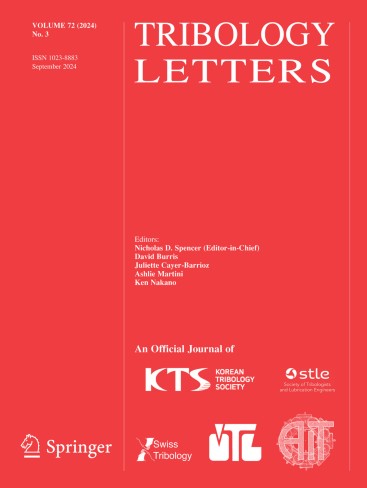摘要
擦伤是在高应力或润滑不良的接触中发现的一种磨损,其特点是摩擦力迅速增加,近表面材料发生严重的塑性变形。事实证明,擦伤难以研究,因为它的发生无法预测、进展迅速,而且通常发生在难以接近的接触界面中。虽然已经成功地对磨损进行了实时的现场研究,但这些研究需要的透明对撞体会改变表面与润滑剂之间的相互作用,从而以未知的方式影响磨损过程。本文介绍了 X 射线兼容摩擦测量法的开发情况,该方法可在现场实时研究自配钢的摩擦磨损情况。该方法采用交叉圆柱体配置,固定部件薄(500 微米厚),接触宽度小(≈200 微米),以最大限度地提高 X 射线与接触产生的应力场中的原子的相互作用。在摩擦学上具有挑战性的 "无油 "润滑条件下,所产生的仪器和方法被用于对自配的 52,100 钢的摩擦响应进行基准测试。结果表明,尽管所使用的接触面积和载荷相对较小,但在这种配置下仍能实现可靠的摩擦。刮擦后,在两个表面上都观察到了严重的塑性变形,以及显著的表面下晶粒细化和流动,只有静止的表面经历了持续的接触。有趣的是,高摩擦开始于间歇接触的迁移表面的特定位置,然后随着时间的推移在整个轨道上传播,这表明迁移表面的局部条件主导了摩擦,导致了失效事件的发生。Scuffing, a type of wear found in highly stressed or poorly lubricated contacts, is characterized by a rapid increase in friction and severe plastic deformation of the near-surface material. Scuffing has proven difficult to study because it initiates unpredictably, progresses rapidly, and typically develops within an inaccessible contact interface. Although there have been successful in-situ studies of scuffing in real-time, the transparent counter body needed for these studies changes the interactions between the surfaces and the lubricant, which affects the scuffing process in unknown ways. This paper describes the development of X-ray-compatible tribometry to study the scuffing of self-mated steels in-situ and in real-time. The method uses a crossed cylinders configuration with a thin (500 μm thick) stationary component and a small (≈200 μm) contact width to maximize X-ray interactions with atoms within the stress field generated by the contact. The resulting instrument and method are used to benchmark the scuffing response of self-mated 52,100 steel under tribologically challenging ‘oil-off’ lubrication conditions. The results demonstrate reliable scuffing in this configuration despite the relatively small contact areas and loads used. Following scuffing, gross plastic deformation was observed on both surfaces along with significant subsurface grain refinement and flow only on the stationary surface, which experienced constant contact. Interestingly, high friction initiated at specific locations of the migratory surface, which experienced intermittent contact, and then propagated across the track over time, suggesting that local conditions of the migratory surface dominated friction leading into the failure event.
Graphical Abstract

 求助内容:
求助内容: 应助结果提醒方式:
应助结果提醒方式:


